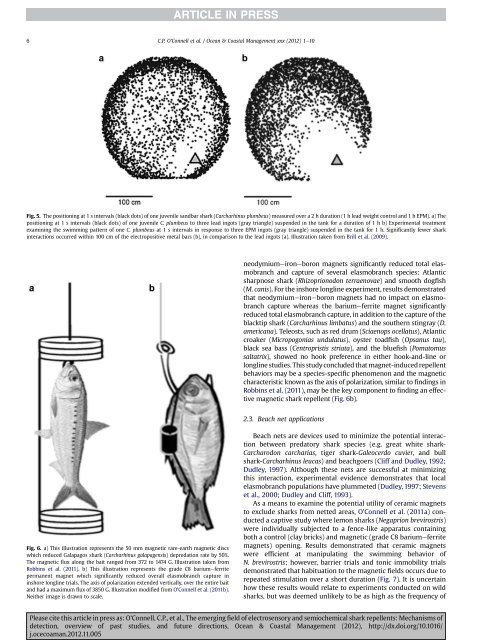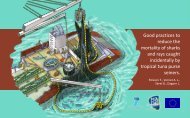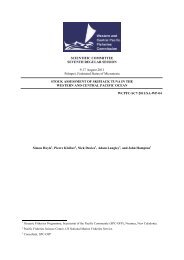The emerging field of electrosensory and semiochemical shark ...
The emerging field of electrosensory and semiochemical shark ...
The emerging field of electrosensory and semiochemical shark ...
Create successful ePaper yourself
Turn your PDF publications into a flip-book with our unique Google optimized e-Paper software.
6<br />
C.P. O’Connell et al. / Ocean & Coastal Management xxx (2012) 1e10<br />
Fig. 5. <strong>The</strong> positioning at 1 s intervals (black dots) <strong>of</strong> one juvenile s<strong>and</strong>bar <strong>shark</strong> (Carcharhinus plumbeus) measured over a 2 h duration (1 h lead weight control <strong>and</strong> 1 h EPM). a) <strong>The</strong><br />
positioning at 1 s intervals (black dots) <strong>of</strong> one juvenile C. plumbeus to three lead ingots (gray triangle) suspended in the tank for a duration <strong>of</strong> 1 h b) Experimental treatment<br />
examining the swimming pattern <strong>of</strong> one C. plumbeus at 1 s intervals in response to three EPM ingots (gray triangle) suspended in the tank for 1 h. Significantly fewer <strong>shark</strong><br />
interactions occurred within 100 cm <strong>of</strong> the electropositive metal bars (b), in comparison to the lead ingots (a). Illustration taken from Brill et al. (2009).<br />
neodymiumeironeboron magnets significantly reduced total elasmobranch<br />
<strong>and</strong> capture <strong>of</strong> several elasmobranch species: Atlantic<br />
sharpnose <strong>shark</strong> (Rhizoprionodon terraenovae) <strong>and</strong> smooth dogfish<br />
(M. canis). For the inshore longline experiment, results demonstrated<br />
that neodymiumeironeboron magnets had no impact on elasmobranch<br />
capture whereas the bariumeferrite magnet significantly<br />
reduced total elasmobranch capture, in addition to the capture <strong>of</strong> the<br />
blacktip <strong>shark</strong> (Carcharhinus limbatus) <strong>and</strong>thesouthernstingray(D.<br />
americana). Teleosts, such as red drum (Sciaenops ocellatus), Atlantic<br />
croaker (Micropogonias undulatus), oyster toadfish (Opsanus tau),<br />
black sea bass (Centropristis striata), <strong>and</strong> the bluefish (Pomatomus<br />
saltatrix), showed no hook preference in either hook-<strong>and</strong>-line or<br />
longline studies. This study concluded that magnet-induced repellent<br />
behaviors may be a species-specific phenomenon <strong>and</strong> the magnetic<br />
characteristic known as the axis <strong>of</strong> polarization, similar to findings in<br />
Robbins et al. (2011), may be the key component to finding an effective<br />
magnetic <strong>shark</strong> repellent (Fig. 6b).<br />
2.3. Beach net applications<br />
Fig. 6. a) This illustration represents the 50 mm magnetic rare-earth magnetic discs<br />
which reduced Galapagos <strong>shark</strong> (Carcharhinus galapagensis) depredation rate by 50%.<br />
<strong>The</strong> magnetic flux along the bait ranged from 372 to 1474 G. Illustration taken from<br />
Robbins et al. (2011). b) This illustration represents the grade C8 bariumeferrite<br />
permanent magnet which significantly reduced overall elasmobranch capture in<br />
inshore longline trials. <strong>The</strong> axis <strong>of</strong> polarization extended vertically, over the entire bait<br />
<strong>and</strong> had a maximum flux <strong>of</strong> 3850 G. Illustration modified from O’Connell et al. (2011b).<br />
Neither image is drawn to scale.<br />
Beach nets are devices used to minimize the potential interaction<br />
between predatory <strong>shark</strong> species (e.g. great white <strong>shark</strong>-<br />
Carcharodon carcharias, tiger <strong>shark</strong>-Galeocerdo cuvier, <strong>and</strong> bull<br />
<strong>shark</strong>-Carcharhinus leucas) <strong>and</strong> beachgoers (Cliff <strong>and</strong> Dudley, 1992;<br />
Dudley, 1997). Although these nets are successful at minimizing<br />
this interaction, experimental evidence demonstrates that local<br />
elasmobranch populations have plummeted (Dudley, 1997; Stevens<br />
et al., 2000; Dudley <strong>and</strong> Cliff, 1993).<br />
As a means to examine the potential utility <strong>of</strong> ceramic magnets<br />
to exclude <strong>shark</strong>s from netted areas, O’Connell et al. (2011a) conducted<br />
a captive study where lemon <strong>shark</strong>s (Negaprion brevirostris)<br />
were individually subjected to a fence-like apparatus containing<br />
both a control (clay bricks) <strong>and</strong> magnetic (grade C8 bariumeferrite<br />
magnets) opening. Results demonstrated that ceramic magnets<br />
were efficient at manipulating the swimming behavior <strong>of</strong><br />
N. brevirostris; however, barrier trials <strong>and</strong> tonic immobility trials<br />
demonstrated that habituation to the magnetic <strong>field</strong>s occurs due to<br />
repeated stimulation over a short duration (Fig. 7). It is uncertain<br />
how these results would relate to experiments conducted on wild<br />
<strong>shark</strong>s, but was deemed unlikely to be as high as the frequency <strong>of</strong><br />
Please cite this article in press as: O’Connell, C.P., et al., <strong>The</strong> <strong>emerging</strong> <strong>field</strong> <strong>of</strong> <strong>electrosensory</strong> <strong>and</strong> <strong>semiochemical</strong> <strong>shark</strong> repellents: Mechanisms <strong>of</strong><br />
detection, overview <strong>of</strong> past studies, <strong>and</strong> future directions, Ocean & Coastal Management (2012), http://dx.doi.org/10.1016/<br />
j.ocecoaman.2012.11.005




